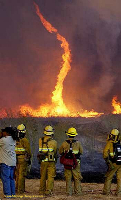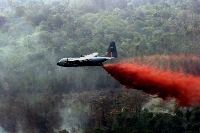SmokeyBear.com - Get Your Smokey On - Only You Can Prevent Wildfires

How do firefighters put out the wildfires?
Firefighters use a tool known as a pulaski. Its a combination of an ax and hoe used to dig a fireline. A fireline is a strip of land from which all brush and debris have been cleared to rob a wildfire of its fuel. Firefighters also use hotshots and smoke jumpers to clear a large path in a big circle around the fire so the blaze is contained in a ring of dirt. When the fire reaches this area, it runs out of fuel and starves to death. If the fire is too large, however, planes and helicopters fly overhead, dropping water and special chemicals that smother the flames. This pink, fire-retardant chemical is called sky jell-o.

Click Here to get the latest wildfire information.
Click Here for to get more wildfire information.
Click Here to see if there has been any recent wildfire activity across the U.S.
SURFACE FIRES - The most common type of wildfires, surface fires move slowly and burn along the forest floor, killing and damaging vegetation.
GROUND FIRES - These are usually started by lightning, ground fires burn on or below the forest floor through the root system.
CROWN FIRES - These fires spread by wind moving quickly along the tops of trees.
SANTA ANA WINDS - "Santa Ana" is the name given to the gusty northeast or east wind that occurs in Southern California during the fall and winter months. Santa Ana winds are often hot and very dry, greatly aggravating the fire danger in forests and bush lands.
CONFLAGRATION - A large and destructive fire, typically aggravated by strong winds that carry firebrands over natural or artificial barriers.
Click Here to learn about more wildfire facts!
BEFORE A WILDFIRE: Have a disaster plan. Know whether you’re in a wildfire prone area. Plant fire resistant shrubs and trees around your home. Have a garden hose that is long enough to reach around your home. Prepare a disaster supplies kit for your home and car. Include a first aid kit, canned food and a can opener, bottled water, battery-operated radio, flashlight, protective clothing and written instructions on how to turn off electricity, gas, and water. Always listen to the radio and television for the latest information and instructions for your area.
DURING A WILDFIRE: If you’re advised to evacuate then do so immediately. Wear protective clothing and lock your home. Tell someone you left and where you are going. Choose a safe route away from fire hazards. Watch for changes in the speed and direction of fire and smoke.
AFTER A WILDFIRE: Stay away from wildfire areas until it is safe.
For more great info see the full site here at Weather Whiz Kids
~~~~~~~~~~~~~~~~~~~~~~~
 |  |  |  |
Read all the information on the Fema for Kids Website
~~~~~~~~~~~~~~~~~~~~~~~~~~~~~
Urwin and Wufi's Adventure with Wildfire
or
Choose A Specific Page To Color:
 [ Page 1 ] |  [ Page 2 ] |  [ Page 3 ] |
 [ Page 4 ] |  [ Page 5 ] |  [ Page 6 ] |
 [ Page 7 ] |  [ Page 8 ] |  [ Page 9 ] |
 [ Page 10 ] |